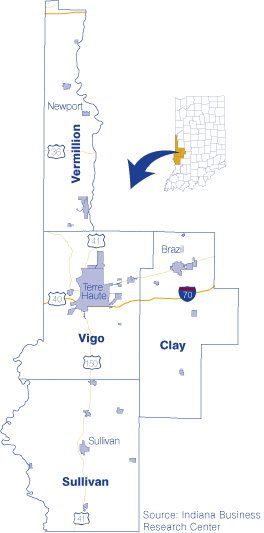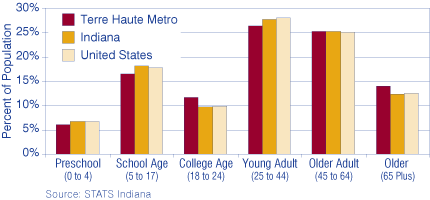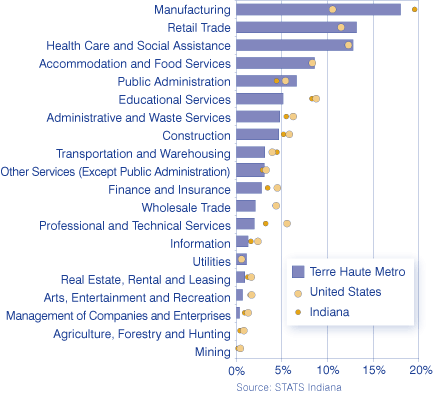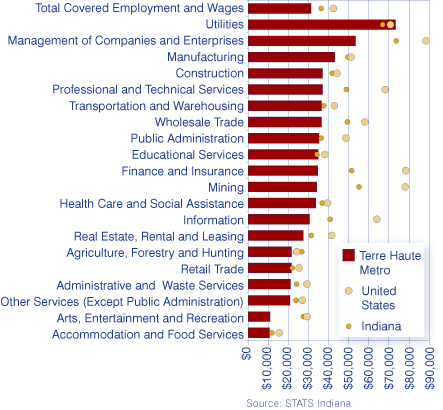The Terre Haute Metro Story: Told by STATS Indiana
The Terre Haute metro is comprised of Clay, Sullivan, Vermillion and Vigo counties (see Figure 1). The metro is one of Indiana's 16 metros highlighted in this series of articles. All the data used in this article are available using the USA Counties and Metros Side-by-Side feature on STATS Indiana (www.stats.indiana.edu).
Figure 1: Terre Haute Metro

The Area
The four counties in the Terre Haute metro make up 2.7 percent of Indiana's population, with slightly more than 168,000 residents. This number has remained fairly constant since 1990, increasing only 1 percent since that time. Meanwhile, Indiana saw a population growth of 13.9 percent and the United States grew 20.3 percent. Looking at migration data, we find that about 350 people moved out of the Terre Haute metro to elsewhere in the United States. Meanwhile, only 142 people migrated into the metro from 2005 to 2006 and there were only 292 more births than deaths.
Looking at the population by age data, we get an even clearer picture of the metro's population. As a proportion of the total population, the Terre Haute metro has a higher percentage of people in the 65 and older age group (14 percent) than does the state or nation (12.4 percent for each). This is coupled with the fact that the metro has a smaller proportion of adults of prime working age (25 to 44 years old). The area does have a higher percentage of college age adults (11.7 percent) than Indiana (9.8 percent) or the United States (9.8 percent) due to the presence of Indiana State University and Rose Hulman in Terre Haute (see Figure 2).
Figure 2: Distribution of Population by Age in the Terre Haute Metro, Indiana and the United States, 2006

Jobs & Wages
After falling in 2005, jobs in the metro rose again in 2006, nearing their 2004 levels. The decline of nearly 300 jobs in 2005 in the Terre Haute metro was not reflected in the state or national numbers, meaning the losses were most likely due to the shutdown or movement of a major employer (i.e., Columbia House closed in Terre Haute in August 2005), as opposed to a nationwide trend. On a more positive note, however, Blu-Ray has won the format wars for high-definition and Applied Extrusion Technologies is consolidating its U.S. operations to the Terre Haute facility, meaning a likely increase in jobs on both counts.1
Manufacturing led the metro's 20 major industries, with 18 percent of total covered jobs (see Figure 3). In fact, manufacturing is the only industry in the metro that supplies more than 10,000 jobs. In Indiana, manufacturing makes up 19.6 percent of jobs. The U.S. figure is a much lower 10.6 percent of total jobs. Retail trade and health care and social assistance were among the top three industries for employment numbers in the metro, Indiana and the United States. On the other hand, there were four industries that made up less than 1 percent of jobs in the Terre Haute metro: arts, entertainment, and recreation; management of companies and enterprises; agriculture, forestry, and hunting; and mining.
Figure 3: Jobs by Industry as a Percent of Total Covered Employment, 2006

Average annual wages in Indiana have consistently lagged the nation, and wages in the Terre Haute metro have consistently lagged the state. It does not help that average annual wages in the metro have been falling since 2004. Unlike with jobs, however, overall wages did fall in Indiana and the United States in 2004, meaning the drop was most likely of an uncontrollable nature for the metro.
There were three industries in the Terre Haute metro that paid average annual wages more than $40,000 per year (see Figure 4). At the top of this list was the utilities industry, which paid average annual wages of $73,236. This was higher than the state and national averages ($67,156 in Indiana overall for utilities workers and $70,855 in the United States). The utilities industry was the only industry in which the metro paid more than the United States. As a percent of the state, however, both utilities and educational services paid more in the metro.
Figure 4: Average Annual Wages by Industry, 2006

While the highest-paid industry paid more than Indiana and the United States, the lowest-paid industry in the Terre Haute metro paid less than the state and nation. The accommodation and food services industry paid $10,766 in the metro, $12,111 in Indiana and $15,753 in the United States.
Conclusion
The Terre Haute metro has seen lackluster performance over the past few years. Population has grown, but at an extremely slow rate compared to the state and nation. Overall wages fell and, for the most part, do not pay as well as Indiana overall or the nation as a whole. Jobs increased but have yet to climb back up to their 2004 numbers, but recent announcements with the potential for additional jobs in the area should help.
Note
- Dan Nystedt, "Toshiba makes it official, abandons HD-DVD format," Computerworld, February 19, 2008. Available online at www.computerworld.com/article/1586769/toshiba-makes-it-official-abandons-hd-dvd-format.html. Information about Applied Extrusion Technologies comes from Inside Indiana Business, "Company Consolidating U.S. Manufacturing Operations in Terre Haute," February 8, 2008. www.insideindianabusiness.com/newsitem.asp?id=27731.
Molly Manns, Associate Editor
Indiana Business Research Center, Kelley School of Business, Indiana University
